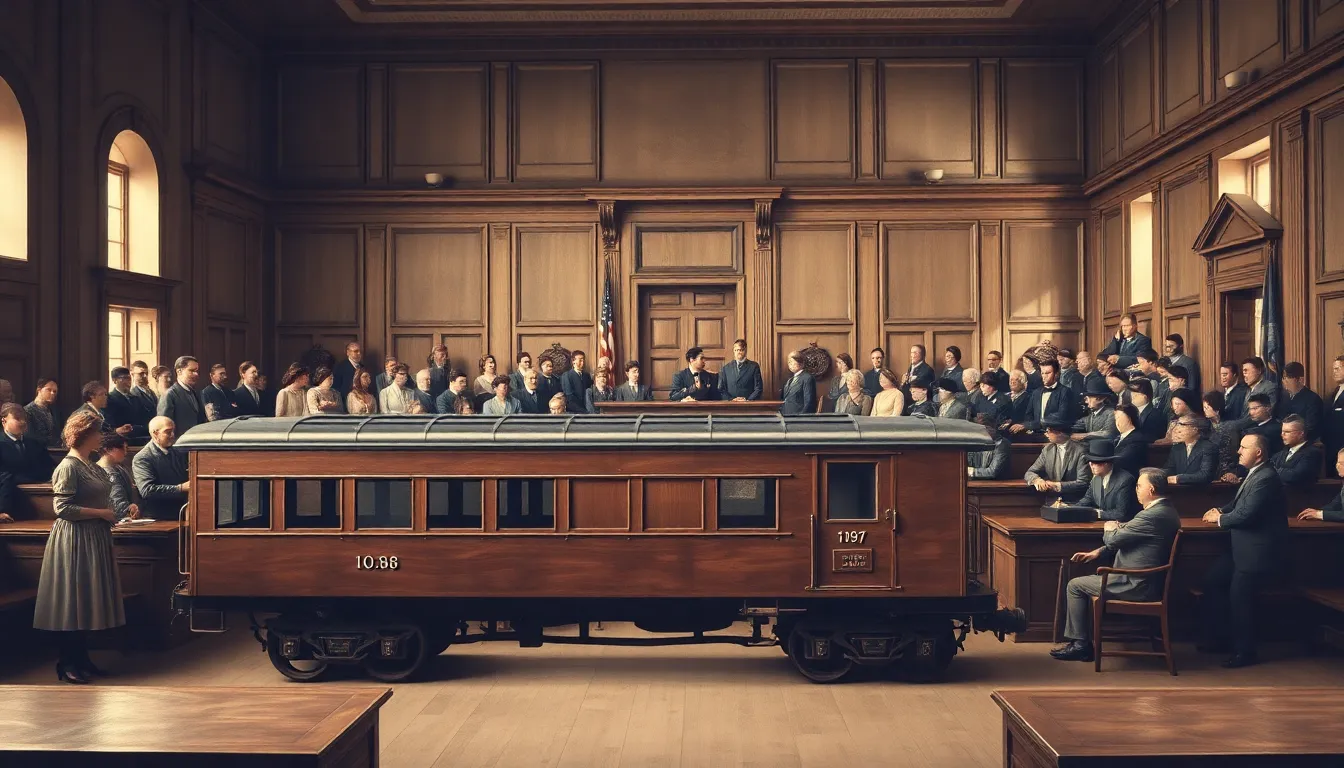Table of Contents
ToggleIn the grand theater of American history, few cases have taken center stage quite like Plessy v. Ferguson. This landmark Supreme Court decision from 1896 is often remembered for its infamous doctrine of “separate but equal.” But what does that really mean? Picture this: a world where riding the train could land you in a courtroom showdown over your skin color. It’s a tale of legal gymnastics that’s both fascinating and a bit outrageous.
Plessy V Ferguson Simple Definition
Plessy v. Ferguson refers to the 1896 Supreme Court case that upheld racial segregation laws. This ruling introduced the doctrine of “separate but equal,” allowing segregation in public facilities. The case involved Homer Plessy, who challenged Louisiana’s segregation laws by sitting in a whites-only railway car.
Racial discrimination became legally sanctioned as a result of this decision. The Court’s majority opinion, written by Justice Henry Billings Brown, stated that state laws requiring separate facilities did not violate the Fourteenth Amendment. Justice Brown argued that as long as the separate facilities were equal, segregation did not imply inferiority.
Dissenting opinions expressed concern over the ruling’s implications, particularly from Justice John Marshall Harlan. Harlan disagreed, stating that the Constitution is color-blind, and the law should treat all citizens equally. Legal scholars argue that this dissent emphasized the case’s long-standing opposition and foreshadowed future civil rights challenges.
Plessy v. Ferguson set a crucial precedent for future cases regarding segregation and inequality. The ruling remained in effect until the Brown v. Board of Education decision in 1954, which eventually overturned “separate but equal.” This landmark case significantly influenced civil rights movements throughout the 20th century. It showed the legal system’s role in endorsing racial inequalities and stimulated further legal battles against segregation.
Historical Context

The case of Plessy v. Ferguson emerged against the backdrop of a deeply segregated America. It highlighted the legal and social challenges surrounding racial discrimination in the late 19th century.
Background of the Case
Homer Plessy, a mixed-race man, deliberately violated Louisiana’s segregation law by sitting in a whites-only railway car. This act of defiance took place on June 7, 1892, leading to his arrest. Plessy’s legal team argued that segregation violated the Fourteenth Amendment’s Equal Protection Clause. The case reached the Supreme Court, where the majority upheld segregation. The ruling emphasized that separate facilities for different races did not imply the inferiority of either race, igniting significant debate.
Jim Crow Laws and Segregation
Jim Crow laws, enacted primarily in Southern states, established racial segregation in numerous public facilities. These laws emerged in the late 19th century as a response to Reconstruction efforts and aimed to maintain white supremacy. Public schools, transportation, and even restrooms enforced segregation, creating a distinct societal divide. Racial discrimination became institutionalized, with “separate but equal” justifying unequal treatment. Plessy v. Ferguson solidified these laws by legitimizing segregation, laying the groundwork for future civil rights struggles.
Key Players in Plessy V Ferguson
The case involves pivotal figures who significantly impacted the outcome and legacy of Plessy v. Ferguson.
Homer Plessy
Homer Plessy was a mixed-race individual who bravely challenged Louisiana’s segregation laws. On June 7, 1892, he deliberately chose to sit in a whites-only railway car, leading to his arrest. His actions stemmed from a deep commitment to civil rights and equality. Plessy’s legal team argued that segregation violated the Equal Protection Clause of the Fourteenth Amendment. They sought to highlight the injustice of racial discrimination in public spaces. Plessy’s courage laid the groundwork for future civil rights activism.
Judge John Howard Ferguson
Judge John Howard Ferguson presided over Plessy’s initial trial. He ruled in favor of the state, stating that segregation laws did not infringe upon the rights guaranteed by the Constitution. Ferguson’s decision reflected the prevailing attitudes of the time, which accepted racial separation as legal. His interpretation emphasized that “separate but equal” facilities met constitutional standards. This ruling became a cornerstone in justifying the continuation of Jim Crow laws. Ferguson’s role underscored the judicial support for racial segregation in the late 19th century.
The Supreme Court Decision
The Supreme Court’s ruling in Plessy v. Ferguson significantly shaped racial segregation laws in the United States. This landmark decision stated that separate facilities for different races were constitutional if they were equal.
Majority Opinion
Justice Henry Billings Brown’s majority opinion upheld Louisiana’s segregation laws. He argued that public facilities could be separated by race, provided that they offered equal quality. Brown emphasized that the Fourteenth Amendment’s Equal Protection Clause did not prohibit racial separation unless it resulted in inequality. The Court concluded that the state was entitled to maintain its laws for social order. Brown’s reasoning supported the doctrine of “separate but equal,” effectively legitimizing segregation across the nation.
Dissenting Opinion
Justice John Marshall Harlan delivered a powerful dissent. His opinion stressed that the Constitution should not recognize racial distinctions. Harlan asserted that the United States should aspire to a color-blind legal system. He believed that allowing segregation contradicted the principles of equality enshrined in the Fourteenth Amendment. Harlan’s dissent foreshadowed future advancements in civil rights, challenging the ruling’s legitimacy. His perspective highlighted the importance of equal treatment under the law, laying groundwork for future reforms.
Impact of the Case
Plessy v. Ferguson had profound impacts on American society and the legal landscape. The case not only legitimized segregation but also established legal frameworks that permitted racial discrimination.
Legal Precedents Established
Plessy v. Ferguson cemented the doctrine of “separate but equal” in American law. Courts across the nation used this ruling to uphold segregation laws until the mid-20th century. Lower court decisions frequently referenced the case as justification for maintaining separate facilities. Schools, transportation, and public spaces upheld racial separation based on this legal foundation. In essence, the case became a benchmark for future rulings regarding racial segregation.
Long-Term Effects on Civil Rights
Long-term effects of Plessy v. Ferguson contributed to systemic racial inequalities. The legitimacy granted to segregation led to a series of Jim Crow laws that enforced racial discrimination for decades. Civil rights activists found their struggles deeply tied to the injustice established by this ruling. Transformations in legal discourse began to arise, pushing for greater equality. Landmark decisions, such as Brown v. Board of Education in 1954, began to challenge the precedents set by Plessy, highlighting the ongoing fight for civil rights. Over time, the case became a symbol of the legal system’s role in perpetuating racial injustice.
Plessy v. Ferguson remains a pivotal moment in American legal history. Its endorsement of the “separate but equal” doctrine not only legitimized segregation but also set a precedent that would influence racial discrimination laws for generations. The case highlighted the deep-rooted inequalities in society and sparked a movement toward civil rights that would challenge the status quo.
The dissenting opinions, particularly from Justice Harlan, remind us of the ongoing struggle for equality and justice. As society reflects on the implications of Plessy v. Ferguson, it serves as a reminder of the importance of vigilance against racial discrimination and the necessity of a truly equitable legal system. The case’s legacy continues to resonate in contemporary discussions about race and justice in America.







